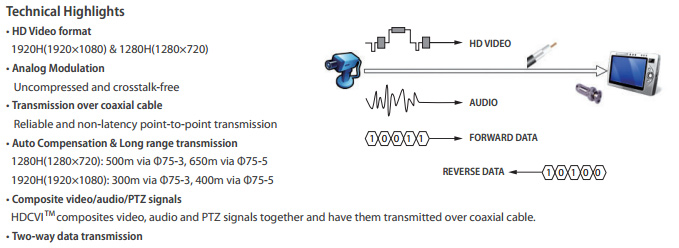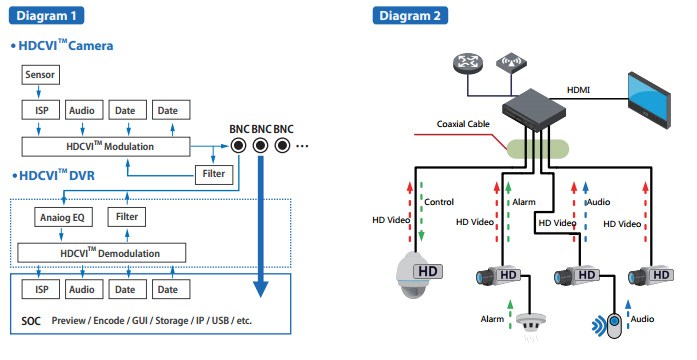
What's HDCVI camera, and its advantage?
What's the HDCVI camera? To answer this question, you need to know what the HDCVI, the HDCVI is the abbreviation of High Definition Composite Video Interface (HDCVI), which is one of recent technologies for offering high definition solution to analog surveillance system (CCTV).
HDCVI is a video transmission technology in high definition via coaxial cable, allowing reliable long-distance HD transmission at lower cost, while complex deployment is applicable. HDCVI modulates video signal to level and then transmit by adopting base-band and quadrature amplitude modulation; which is also the reason of its naming. This technology avoids the cross talk of CVBS and completely separates the brightness signal and hue signal, hence further enhances video quality. HDCVI offers two specifications — 1920H (1920×1080) and 1280H (1280×720); which are compatible with the industrial standard 1080p(1920×1080) and 720p(1920×1080).

What's the difference between HDCVI and traditional analog camera? As we know, traditional analog camera utilizes CCD image sensor to capture images, which comes with interlaced scan, its highest resolution is 960H (960x480, or 960x576). In order to compete with IP camera, some manufacturers developed analog camera which is based on progressive scan CMOS image sensor, hence to deliver megapixel resolution images (720p & 1080p).
Interlaced scan vs progressive scan
What differentiates a progressive scan from an interlaced scan is that the progressive scans system draws every line on the screen in just one pass, rather than in two passes.
- Disadvantages of interlaced scan: Image artifacts, Intentional image blurring, Improper reproduction of finer details, Image flickering (This flickering is also called “interline twitter” and is caused by the image on the screen containing vertical detail that approaches the horizontal resolution of the video format.)
- The advantages of progressive scan: No image artifacts, No blurring, Higher vertical resolution, Higher quality images (Images are smoother are more detailed in progressive scan as they are refreshed at a faster frequency.)
Back to 2014, HDCVI, HDTVI, HDAHD (or AHD) technologies were released by different manufacturers. End-users are happy to embrace these new technologies, because they give them the chance to upgrade existing standard surveillance system to HD analog system. Unfortunately, some users like me feel overwhelmed, because they are too similar on both features and price. Which one is the best? In my humble opinion, there is no best one, each technology has its unique advantage, but all of resolution (image performance) keep same without significant difference.

Let's continue introducing the HDCVI technology, HDCVI features a patent named auto signal compensation (ASC), which only allows an extremely low signal distortion along long-distance transmission. HDCVI solution incorporates both cameras and DVRs, and the system is star topology structured; DVR is served as a node to have an over coax P2P (Point-to-Point) transmission to camera. Cable selection is based on transmission distance: cable 75-3 and 75-5 are recommended for transmission within 500 meters, cable 75-5 and above for over 500 meters. Connector or jointing technology could be applied for connecting and the installation is exactly the same as that of conventional analog devices, which posts no special requirements either for indoor or outdoor scenarios with better anti-interference capability offered.

To further realize multiple-signal transmission over one cable, both audio signal and dual-way data communication signal are embedded in a blanking zone; which enhances the synchronization with video signal; and max supports 44.1kHz sampling rate thanks to ASC. The forward and reverse data channels composite in the frame blanking zone, realizing a two-way end-to-end transmission to support control commands such as camera focus, PTZ control, real-time alarm and etc. The forward outputting data supports high transmission baud rate as the sending time and electric signal baud rate are predictable, meanwhile, the receiving end is of high ASC performance;

on the other hand, the reverse outputting data supports lower baud rate due to its low signal frequency and limited data, which is elected by the impedance matching. However, with ASC adopted, the reverse channel could restore electric signal during long-distance transmission at some degree.Therefore, HDCVI is an optimal solution for megapixel high definition application, featuring non-latent long-distance transmission at lower cost.
Get My Latest Posts
Subscribe to get the latest updates.
Your email address will never be shared with any 3rd parties.
Tags: HDCVI, HDCVI Camera